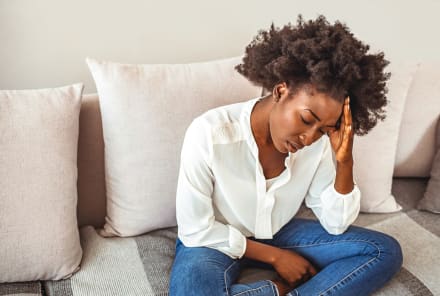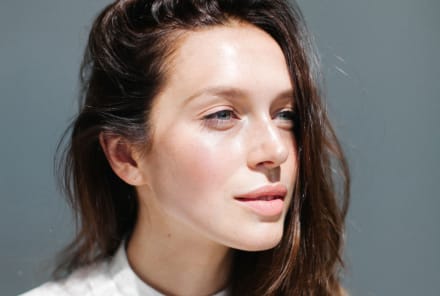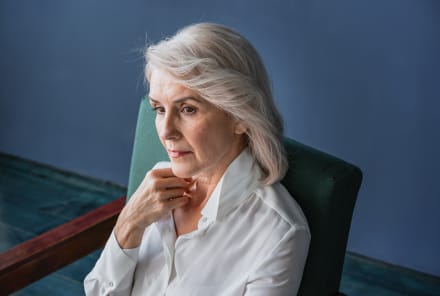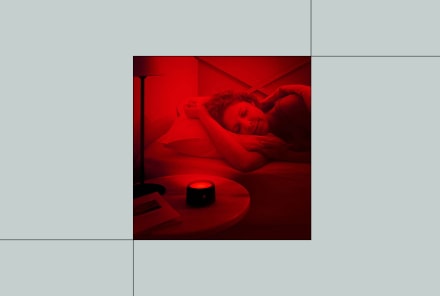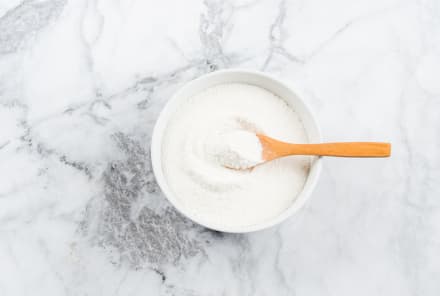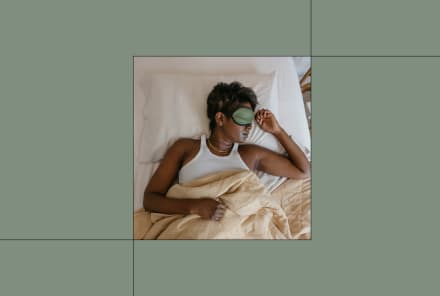Advertisement
Beat Cramps & PMS With This Self-Massage Acupressure Routine

Paige Bourassa is a licensed acupuncturist with a thriving practice in the heart of New York City. Paige has joined mbg to create a new class that gives you the tools you need to relieve pain with acupressure, a simple technique that you can do sitting at your desk or lying down at home. Sign up here for her exclusive, live webinar on February 13, to get your personal acupressure questions answered!
We've all been there. It's the week before your period and you're crying at the life insurance commercials, giving everyone on your morning commute major stinkeye, or simply feeling like nobody is on your side. It's the dreaded PMS, and if you're unlucky, that's then followed by a couple of days of menstrual cramps, leaving you feeling like a mess. Thankfully, these two conditions are a couple of my specialties. Using the points and knowledge from acupuncture, I've designed a targeted acupressure routine you can do on your own to help get relief from PMS, cramps, and bloating.
According to TCM (traditional Chinese medicine), there are many different pathologies that may result in your experience of PMS and menstrual cramps. Whenever a new patient comes into my practice, I make sure all of their past medical history is discussed so I can paint a clear picture of what is presently going on in his or her body and why. The "why" is looking at the patient's environment, her lifestyle, and her emotions to pinpoint how the current situation came to be. PMS, as we know, is totally different in each person.
Here are 3 types of PMS, according to traditional Chinese medicine.
- Blood deficient: Some of us get timid and fearful, we need reassurance and support. That type of pattern is more "blood deficient," so we would focus on treatments and herbs to nourish them.
- Liver qi stagnation: Others get furious, often blowing up out of nowhere or feeling extremely frustrated. That type of pattern is typically "liver qi stagnation" and needs to be moved, vented, and released.
- Spleen qi deficiency: Other women worry, eat everything in sight; think of all worst-case scenarios; and feel sluggish, bloated, and can't fit into their pants for a week. This type is a common "spleen qi deficiency," which needs to be tonified, strengthened, and energized.
There are many more patterns and even combination patterns that are unique to each person, so it's important to get your diagnosis right. In the meantime, here are my favorite acupuncture points that you can use as acupressure points on the fly to help your menstrual struggles. Mix and match or do them all, but most importantly breathe and remember to self-soothe.
The video above touches on a few points below and gives you a general idea of how to massage and apply pressure. Here's the full list:
Move stagnant emotional energy with Liver 3.
Liver 3 is one of the most commonly used acupuncture points on the body, and its specialty is moving stagnant emotional energy. This point works wonders for anger, frustration, hopelessness, emotional roller coasters, cramping pain, breast tenderness, and heat sensations in the abdomen.
Locate this point: LV3 is found in the tender webbing between the knuckles of the big and second toe. Press both points on each foot firmly, for 60- to 90-second intervals while breathing deeply in through the nose and out through the mouth.
Calm headaches and pain with Large Intestine 4.
Known as the "pain" point, Large Intestine 4 is commonly used for migraines and headaches but can also be used for pain experienced anywhere in the body. LI4 moves qi and stagnation in the acupuncture channels, so it is ideal to address menstrual cramps and pain.
Locate this point: This point is in the soft webbing between the thumb and index finger. Find the tender indent in the flesh and that's the spot. Press these points on each hand firmly for 60- to 90-second intervals, while breathing deeply in through the nose and out through the mouth.
Massage Spleen 8, which is specifically linked to the menstrual cycle.
This point is an absolute must for intense menstrual cramps. It runs along an incredibly tender channel on the inner aspect of the tibia bone, which gives a lot of relief when massaged. Spend your time massaging in and around this point.
Locate this point: It can be located by finding the knee crease on the inner leg and tracing down the tibia bone about 5 to 7 inches until you find a very tender spot. Rub and hold in 60- to 90-second intervals on both sides of the leg; massage the whole tender area on the inside of the shin bone until you feel relief. Continue the breathing in through the nose and out through the mouth.
Press into your inner ankle area, also known as Kidney 6.
"Shining Sea" is the Chinese name for Kidney 6, an acupuncture point used to alleviate cramps by harmonizing menstrual irregularities and pain in the abdomen. The kidney channel runs up the leg and is one of the main channels running through the female reproductive organs, so it is essential to add a kidney point into any PMS or menstrual cramp protocol.
Locate this point: KI6 can be found approximately 1 inch below the inside of the ankle bone. The best location tool is to trace your finger from the ankle bone notch down until it falls off into a tender spot. Once you find it, massage that area for 90-plus seconds, and move your fingers in the surrounding area all along the arch of the foot as there are several other menstrual-cramp-alleviating points there.
Gently stroke your third eye, also known as Yin tang.
Incredibly calming and a great way to take yourself from 10 to 1 when you're ready to rage, Yin tang is a good point to add to any acupressure protocol just to get in the right headspace.
Locate this point: Located between the eyes on the forehead, it's right where your third eye is and when gently massaged feels heavenly. Using your index finger, gently stroke the point for 60 to 90 seconds as if you are petting a small animal. This is the only point you don't need to be firm with; it's energetically sensitive, so be careful with it.
The most important thing with these points and protocols is to remember to breathe—in through your nose and out through your mouth. Relax a little, and if you can, go somewhere safe and comfy while you do them. A high level of comfort will increase the benefits by a long shot! If you're experiencing chronic menstrual pain and PMS, come see me in New York City or find your local acupuncturist for an appointment. Until then, keep pressing and massaging yourself with the above!
Want more? Learn how to clear your brain fog, calm allergies, and bust bloating—all with acupressure.

Dr. Paige Bourassa is the founder of Shen Medicine, an Acupuncture wellness practice in the heart of New York City and Shen Medicine South, in Nashville Tennessee.
Paige grew up in Vancouver, Canada and became passionate about Alternative Medicine after having several remarkable experiences with it at a young age. After High School she enrolled in Canada’s first Holistic Nutrition program at the Canadian College of Natural Nutrition and graduated a Registered Holistic Nutritionist. From there she traveled extensively through Asia where her passion blossomed into studies as she began taking an interest in Ayurveda, an ancient East Indian medicine. After living in India for several months she moved to Albuquerque, New Mexico to pursue her Ayurvedic training further studying alongside the famous Dr. Vasant Lad at his Ayurvedic Institute. Following Ayurveda, Paige pursued a Psychology degree at the University of Colorado and began to assimilate what she had learned of Eastern Medicine with Western Psychology. Understanding that disease in the body is most often attributed to disharmony within the psyche/emotions, a concept called “Psychosomatic Illness”, Paige was drawn to the integrative philosophy of Traditional Chinese Medicine where everything is believed to be interconnected. After falling in love with the TCM approach to health science, she went on to complete a 4-year Masters of Science degree as well as a Doctorate in Acupuncture and Traditional Oriental Medicine from Pacific College of Health and Science.
More from the author:
The Essential Guide To Acupressure
Check out Relieve Chronic Pain Through The Power Of At-Home Acupressure Techniques
More from the author:
The Essential Guide To Acupressure
Check out Relieve Chronic Pain Through The Power Of At-Home Acupressure Techniques

Dr. Paige Bourassa is the founder of Shen Medicine, an Acupuncture wellness practice in the heart of New York City and Shen Medicine South, in Nashville Tennessee.
Paige grew up in Vancouver, Canada and became passionate about Alternative Medicine after having several remarkable experiences with it at a young age. After High School she enrolled in Canada’s first Holistic Nutrition program at the Canadian College of Natural Nutrition and graduated a Registered Holistic Nutritionist. From there she traveled extensively through Asia where her passion blossomed into studies as she began taking an interest in Ayurveda, an ancient East Indian medicine. After living in India for several months she moved to Albuquerque, New Mexico to pursue her Ayurvedic training further studying alongside the famous Dr. Vasant Lad at his Ayurvedic Institute. Following Ayurveda, Paige pursued a Psychology degree at the University of Colorado and began to assimilate what she had learned of Eastern Medicine with Western Psychology. Understanding that disease in the body is most often attributed to disharmony within the psyche/emotions, a concept called “Psychosomatic Illness”, Paige was drawn to the integrative philosophy of Traditional Chinese Medicine where everything is believed to be interconnected. After falling in love with the TCM approach to health science, she went on to complete a 4-year Masters of Science degree as well as a Doctorate in Acupuncture and Traditional Oriental Medicine from Pacific College of Health and Science.
Watch Next
Enjoy some of our favorite clips from classes
Enjoy some of our favorite clips from classes
What Is Meditation?
Mindfulness/Spirituality | Light Watkins
Box Breathing
Mindfulness/Spirituality | Gwen Dittmar
What Breathwork Can Address
Mindfulness/Spirituality | Gwen Dittmar
The 8 Limbs of Yoga - What is Asana?
Yoga | Caley Alyssa
Two Standing Postures to Open Up Tight Hips
Yoga | Caley Alyssa
How Plants Can Optimize Athletic Performance
Nutrition | Rich Roll
What to Eat Before a Workout
Nutrition | Rich Roll
How Ayurveda Helps Us Navigate Modern Life
Nutrition | Sahara Rose
Messages About Love & Relationships
Love & Relationships | Esther Perel
Love Languages
Love & Relationships | Esther Perel
What Is Meditation?
Box Breathing
What Breathwork Can Address
The 8 Limbs of Yoga - What is Asana?
Two Standing Postures to Open Up Tight Hips
How Plants Can Optimize Athletic Performance
What to Eat Before a Workout
How Ayurveda Helps Us Navigate Modern Life
Messages About Love & Relationships
Love Languages
Advertisement
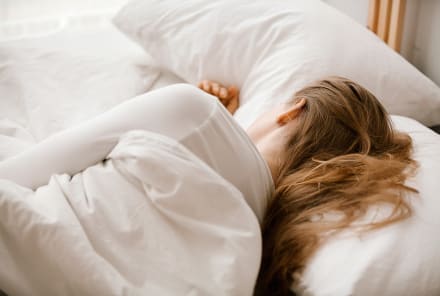
This Little-Known Supplement Helps Women Sleep & Decreases Signs Of Depression
Molly Knudsen, M.S., RDN

This Little-Known Supplement Helps Women Sleep & Decreases Signs Of Depression
Molly Knudsen, M.S., RDN
